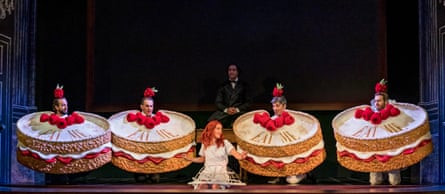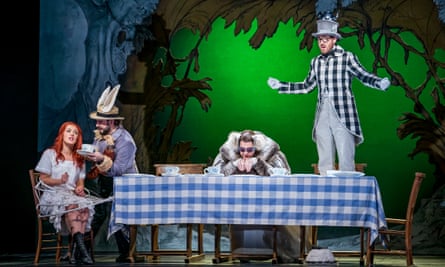When Alice’s Adventures Under Ground received its European premiere at the Barbican three years ago, it seemed more likely to find a permanent home in the concert hall rather than the opera house. Gerald Barry’s gleeful, picaresque romp through Lewis Carroll’s two Alice books seemed to have produced a work that was more cantata than viable, stageable opera – events and characters almost lifted haphazardly from the texts without much sense of a linear narrative and crammed into a score that lasted a breathless 50 minutes. How could any stage production cope with a piece that zigzagged from one scene to another at such dizzying speed?
Yet Antony McDonald has succeeded in doing just that in a spectacularly successful way. It was McDonald who first released the full operatic potential of Barry’s whirlwind The Importance of Being Earnest with his 2013 production for Northern Ireland Opera, and he applies the same, unfailingly light touch to his staging of Alice for the Royal Opera, with witty designs and pinpoint stagecraft that never puts a foot wrong. The speed at which everything happens doesn’t appear to faze him: within seconds of the very start, as the White Rabbit announces his lateness, Alice has tumbled down the rabbit hole with a torrent of coloratura arpeggios, and encountered the all-male chorus of four “Drink me” bottles that swiftly transform into “Eat me” cakes.

And so it continues. A 19th-century toy theatre provides the frame, and at one point a cardboard cutout of Queen Victoria and her family is whisked across the stage. The four men in the cast of seven become choruses of babies and oysters, as well as taking on solo roles (an average of 10 different parts per singer). Barry’s selection of scenes seems to be weighted slightly towards Carroll’s second book, Through the Looking Glass, with its persistent allusions to chess, though the White Rabbit, the Duchess, the Cook, the King and Queen of Hearts and the Tea Party all appear from Alice’s Adventures in Wonderland. Wherever they’re from, McDonald finds hilariously charming representations for them all, and adds another twist with a trio of dancers (Lukas Hunt, Bianca Hopkins and Eloise Hymas) who represent Carroll himself and the historical Alice’s sisters, Lorina and Edith Liddell.
Barry’s music adds its own extra surreal layer, whether it’s the machine-gun delivery of much of the text, the outrageously high soprano writing he inflicts on Alice, or the way in which he seems to embed a whole bundle of musical traditions and references in his score – the use of It’s a Long Way to Tipperary in his setting (in Russian and French) of Jabberwocky; Humpty Dumpty’s melancholy appropriation of Beethoven’s Ode to Joy; or the strangely touching chorale sung by the White Rabbit to end the opera. Meanwhile, the orchestral writing, marshalled with tremendous panache by Thomas Adès, hurls everything at the audience with manic intensity, whether it’s jagged brass, tipsy, tumbling woodwind lines or the wind machines cranked up in the final moments.

The show is double-cast for its short run. Both lineups are uniformly excellent: Claudia Boyle and Jennifer France are the Alices, coping fearlessly with Barry’s outrageous demands on their vocal agility, Boyle marginally more feisty as a stage presence, France perhaps getting more of her words across. It’s almost invidious to pick out other names from either cast in what is such a brilliantly executed ensemble piece, but Hilary Summers is a formidable White Queen and Joshua Bloom a wonderfully lugubrious Humpty, while having Nicky Spence and Robert Murray as the two tenors in the second cast is luxury indeed. It’s altogether wonderfully realised, bringing Barry’s surreal world to life more successfully than anyone could possibly have imagined.

Comments (…)
Sign in or create your Guardian account to join the discussion